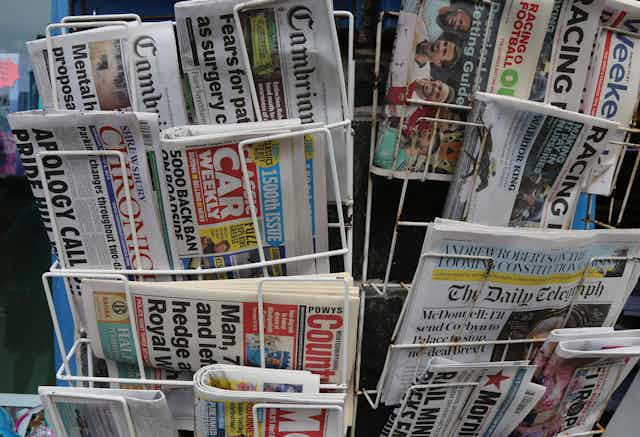Local newspapers have seen sales of their print copies in decline for decades and, with regional newspaper groups regularly cutting staff, it has felt like UK local news journalism might be on the way out – to be replaced by WhatsApp groups or Facebook chat.
But interest in news from people’s own neighbourhoods has prompted a significant digital spike this year. Hundreds of thousands of people have turned to their local newspaper websites during the pandemic for a clearer understanding of the local implications of this national crisis.
The Nottinghamshire Live site, run by Reach Plc, has just seen its highest numbers ever in a single month, 25 million page views, in October this year. The second-highest month ever was in April 2020.
At the Bishop’s Stortford Independent, a weekly paper in Hertfordshire, the monthly web audience increased from 260,000 in January to 360,000 in October. The newspaper team was adding more stories to the website than previously, and also launched an app as a reaction to the demand for stories.
Newsquest, one of the biggest owners of regional UK media, announced in early December it is to turn its weekly paper in Oldham into a daily, the company said one of the reasons was that “the title has seen record audience numbers online over the last six months”.
Local voices
With millions confined to their homes during lockdowns, where do you turn to during the pandemic if you want to find out whether the local surgeries are open or where you can buy a toilet roll? Day-to-day details about where to find a COVID testing centre or council grants were at the heart of local news over the past nine months.
“The restrictions are so local that the only place you can find out the information you need for where you live is from your local publisher. It is affecting peoples’ lives in an extreme way,” said Natalie Fahy, editor of Nottinghamshire Live and the Nottingham Post newspaper.
Alastair Machray, editor-in-chief of the Liverpool Echo, told me: “We saw it very much as our responsibility to lift the clouds of confusion by writing explanatory content.”
Tracey Bagshaw, group editor of the Just Regional group, which includes local news magazines in north Norfolk, said that a lot of what was published at the beginning of the pandemic was “very much in the information mode.
"And it just seemed important, because a lot of people were saying we don’t know, and it was an uncertain time”, she said, adding that: “people wanted news immediately. They don’t want to wait until Friday, to find out what was happening. They wanted to know, on Tuesday morning.”
An upside from the past few months has been more interaction with readers – which has allowed news sites to learn more about their readers wanted, who they were, and what sort of stories they were searching for. “So you’d know exactly sort of how a post was doing, what stories were – and we’re actually picking up comments from readers,” said Bagshaw.
A matter of trust
When it comes to the vital issue of trusting information, there is still an important point of difference between local papers and WhatsApp groups. Newspapers and sites run by trained journalists have a commitment to fact-checking, asking challenging questions of local authorities and digging into a local issue.
During the pandemic, most local news sites published a mix of detail about how hospitals were coping and case numbers, but also focused on how people were helping each other. The positive stories about communities started to attract significant numbers of readers, too. Said Bagshaw:
There were lots of pictures of people painting rainbows and delivering food and, you know, just helping others. Alongside the stories about how local buildings are being turned into temporary mortuaries or being turned into temporary accommodation for the homeless.
Local news companies also tried out new ideas during the pandemic, some offering print subscriptions as gifts, others trying out technology to record interviews without leaving home or new software to keep reporters in touch with each other.

Whether this rise in digital traffic signals a new era for UK local news is unclear. Certainly, it could just be a reaction to the crisis, and reader numbers could slip back to previous levels. But with more of the population likely to work from home in years to come, interest in the local community may become increasingly important to people who no longer spend significant parts of their week on long commutes.
Machray believes that the audience will continue to grow. “My sense is that the reputation of the regional media has been enhanced massively through COVID due to the efforts and expertise, they’ve expended on behalf of their readership.”
Generating revenue
But as well as holding on to their bigger online audiences, companies still need to find new revenue streams to replace levels of advertising in their print copies. For most digital advertising has not delivered this, and print sales continue to fall.
One inspiration is Mark Thompson, who stepped down as chief executive of the New York Times this summer after turning around the newspaper’s finances. During his time there, paying subscribers rose to five million and it added more journalists, going against the industry trend.
Closer to home is another model, the family-owned news business Iliffe, which added four new local papers to its portfolio in the last 18 months. The company’s chief executive, Edward Iliffe, said the key to their success is a focus on the “parochial”.
His newspapers have drawn on old-style journalism with council reports, local football results – and, before the pandemic struck, were even providing a slice of cake for readers who popped into their town centre offices.
Finding the right balance of news may help local news teams work out what their future needs to look like.

